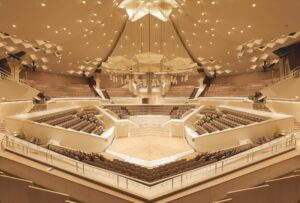
CHOPIN Between Past and Future
The concert series CHOPIN PLUS presents the famous piano works of Frédéric Chopin in a compelling dialogue between tradition and modernity.
Internationally acclaimed pianist Pietro Massa invites the audience to experience the timeless magic of Chopin’s music in the context of past and future sounds. In annual matinées, held on the first Sunday in May, Massa unveils the extraordinary connections between Chopin’s oeuvre and the visionary soundscapes of other composers.
Each concert invites the audience to an inspiring musical dialogue between Chopin and another "composer colleague" – always with Chopin at the center of various intersections. These performances reveal the enduring relevance of Chopin’s featured works, showing listeners why he is the soul of this series.
Through meaningful comparisons between Chopin’s piano works and compositions from eras far before or after his time, the stylistic connections and contrasts in the music become an engaging and tangible experience.
The series will launch in 2025 and span multiple seasons, featuring one matinée concert per year in the Chamber Music Hall of the Berlin Philharmonie:
PREMIERE | SUN, May 4, 2025 (11 AM)
Chopin + Bach
NEXT CONCERT | SUN, May 3, 2026 (11 AM)
Chopin + Debussy
Upcoming Concerts

BERLINER PHILHARMONIE
CHOPIN PLUS 2026

BERLINER PHILHARMONIE
CHOPIN PLUS 2025
PREMIERE IN BERLIN
Berliner Philharmonie | Chamber Music Hall
Sunday, May 4, 2024 | 11 am
PROGRAMME
Johann Sebastian Bach
Goldberg Variations BWV 988
Frédéric Chopin
24 Préludes Op. 28
___
With his 24 Préludes Op. 28, Chopin clearly drew inspiration from Johann Sebastian Bach’s Well-Tempered Clavier to systematically explore the universe of all 24 major and minor keys. In their fragmentary nature—what Theodor W. Adorno described as “a brief form pointing questioning toward the infinite”—and their monumental emotional scope, Chopin’s Préludes represent a pinnacle of the Romantic piano repertoire.
Bach’s Goldberg Variations, on the other hand, stand as a masterpiece of Baroque variation art. Although the overall structure remains anchored in the primary key of G major/minor, each of the 30 variations possesses its own unique character. The symmetrical structure (Aria + 15 Variations | 15 Variations + Aria) and the schematic internal organization (10 groups of three variations each) provide a framework for diverse musical expressions, firmly establishing the Goldberg Variations as a timeless masterpiece within the piano literature.